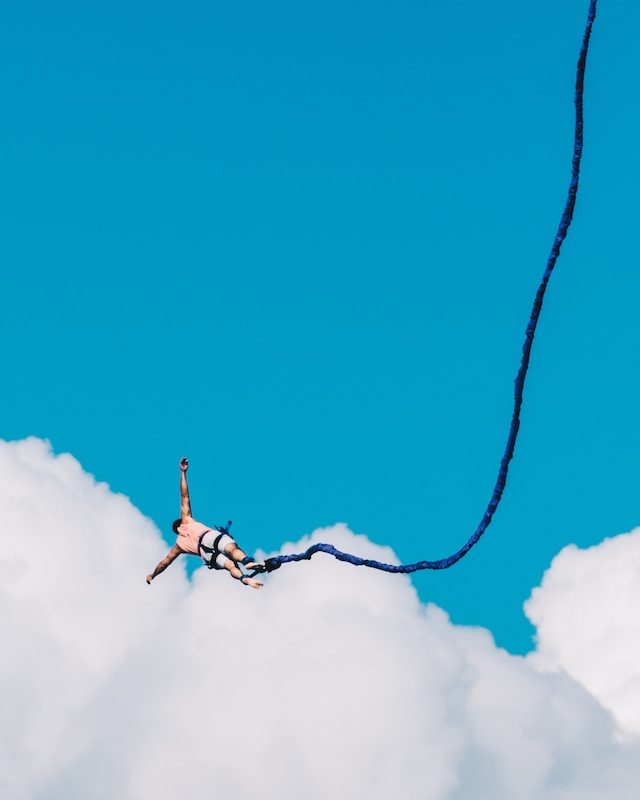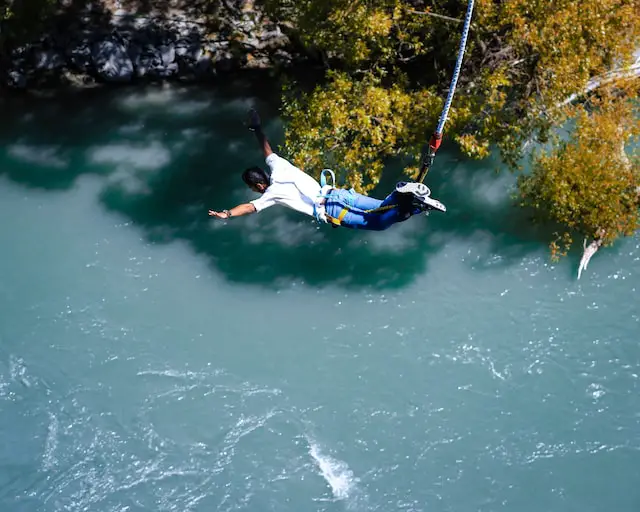Bungee jumping usually takes place from a stationary platform, whereas skydiving involves jumping out of an aeroplane. Bungee jumpers are typically attached to a large elastic cord, while skydivers wear parachutes.
What is Bungee Jumping?
(Photo by Jeffrey Grospe on Unsplash )

Bungee jumping is an exhilarating adventure sport that involves leaping from a high platform or structure while attached to a specially designed elastic cord. The jumper experiences a thrilling freefall as the cord stretches and then recoils, ultimately bringing them to a controlled stop just above the ground or water surface.
The origins of bungee jumping can be traced back to the land diving rituals of the Pentecost Island in Vanuatu, where men would jump from wooden platforms with vines tied around their ankles as a rite of passage. This traditional practice eventually inspired the modern recreational activity of bungee jumping.
To ensure safety, bungee jumping is typically conducted at dedicated bungee jump sites or platforms specifically designed for the activity. The structures used for jumps can vary, including bridges, cranes, or purpose-built towers. Professional operators and jump masters carefully calculate the length and elasticity of the bungee cord based on the participant’s weight and the intended freefall distance.
Participants are usually provided with safety equipment, such as a harness or ankle attachments, which are securely connected to the bungee cord. Before the jump, trained instructors provide detailed instructions and safety briefings to ensure that participants understand the proper jumping technique and any necessary precautions.
Once ready, the jumper takes a leap of faith, diving off the platform into the void. During the initial freefall, which lasts only a few seconds, the sensation of weightlessness and the rush of adrenaline are unparalleled. As the bungee cord reaches its maximum extension, it gradually slows the descent and brings the jumper to a controlled stop. The cord then recoils, allowing the jumper to bounce back up and experience a series of oscillations until they come to a rest.
Bungee jumping offers a unique blend of thrill, adventure, and an intense adrenaline rush. It attracts thrill-seekers who crave the excitement of freefalling and the exhilarating sensation of being suspended in mid-air. While safety precautions are essential, bungee jumping remains an activity that pushes the boundaries of personal limits and provides unforgettable experiences for those seeking a true adrenaline-pumping adventure.
What is Skydiving?
(Photo by Kamil Pietrzak on Unsplash )

Skydiving is a thrilling adventure sport that involves jumping from an aircraft and freefalling through the sky before deploying a parachute to slow the descent and safely land on the ground. It is an exhilarating experience that offers a unique perspective of the world from thousands of feet above.
The skydiving process typically begins with a comprehensive briefing by experienced instructors, covering safety procedures, equipment usage, body positioning, and parachute deployment techniques. Participants are fitted with a jumpsuit, harness, helmet, and other necessary safety gear.
Once prepared, the skydiver boards an aircraft that ascends to the desired altitude, often ranging from 10,000 to 15,000 feet (3,000 to 4,500 meters) above the ground. During the ascent, individuals can enjoy breathtaking views and build anticipation for the upcoming jump.
Upon reaching the designated altitude, the skydiver, usually attached to an instructor for tandem jumps or equipped with their own parachute for solo jumps, positions themselves at the aircraft’s exit. With a final countdown, they leap into the vast open sky, initiating the adrenaline-fueled freefall.
During freefall, which typically lasts for about 30 to 60 seconds, skydivers experience an incredible rush as they descend through the air at speeds of around 120 miles per hour (190 kilometers per hour). The sensation of weightlessness and the panoramic view of the surroundings create an unparalleled sense of freedom and excitement.
At a predetermined altitude, the skydiver deploys their parachute, which slows down the descent and allows for a controlled descent to the ground. Skydivers can then steer the parachute using hand controls, enjoying a serene canopy ride as they descend gradually.
The final phase involves the landing, where the skydiver aims for a designated landing area and executes a controlled touchdown. Experienced skydivers often perform advanced maneuvers, such as turns, spirals, or even aerial formations, to enhance their skills and add further excitement to the sport.
Skydiving offers an incredible adrenaline rush, a unique perspective of the world, and an unparalleled sense of freedom. It requires proper training, adherence to safety protocols, and often the guidance of qualified instructors, especially for beginners. Whether pursued as a one-time thrill or as a lifelong passion, skydiving provides an unforgettable experience that pushes personal boundaries and creates lasting memories.
Bungee Jumping Vs Skydiving – Key differences
Bungee jumping and skydiving are both thrilling adventure activities that involve jumping from heights and experiencing a rush of adrenaline. However, there are key differences between the two:
Altitude: Bungee jumping typically takes place at a lower altitude, often from structures like bridges or towers, ranging from around 100 to 200 feet (30 to 60 meters) high. In contrast, skydiving involves jumping from an aircraft at much higher altitudes, usually between 10,000 and 15,000 feet (3,000 to 4,500 meters) above the ground.
Freefall Duration: The duration of freefall differs significantly. In bungee jumping, the freefall lasts only a few seconds before the bungee cord reaches maximum extension and recoils, bringing the jumper to a stop. In skydiving, freefall typically lasts for around 30 to 60 seconds, allowing for a longer period of thrilling descent before deploying the parachute.
Equipment: Bungee jumping relies on a specialized elastic cord that stretches and recoils to arrest the fall and provide a bouncing effect. Participants are usually equipped with a harness or ankle attachments connected to the bungee cord. In skydiving, participants wear a jumpsuit, harness, helmet, and deployable parachute system, ensuring a safe descent and landing.
View and Perspective: Bungee jumping offers a close-up perspective of the surroundings during the brief freefall, with a focus on the immediate vertical drop. Skydiving, on the other hand, provides a broader and more expansive view as participants experience a longer freefall and enjoy a panoramic vista from the sky.
Training and Certification: While bungee jumping can often be done without extensive training, skydiving requires proper training and certification. Skydivers must undergo training programs to learn about safety procedures, equipment usage, body positioning, parachute deployment, and emergency protocols. Bungee jumping, particularly from established facilities, may involve brief instruction and safety briefings but generally does not require in-depth training.
Solo vs Tandem: Bungee jumping can be done individually, with the participant making the jump alone or with minimal assistance from an instructor. Skydiving offers the option of tandem jumps, where a participant is securely attached to an experienced instructor who controls the parachute descent. Solo skydiving is also possible for certified skydivers.
Both bungee jumping and skydiving provide thrilling experiences, but the choice ultimately depends on personal preferences, desired duration of freefall, altitude comfort, and the type of adventure one seeks.
What’s scarier: skydiving or bungee jumping?
There is no definitive answer to this question as it depends on the individual. Some people may find skydiving to be more daunting as it involves free-falling from a great height, while others may feel that bungee jumping is more terrifying due to the sudden jolt when the cord reaches its full length. Ultimately, it is up to the person to decide which activity they believe to be more frightening.
Featured Image By Anoof Junaid on Unsplash








